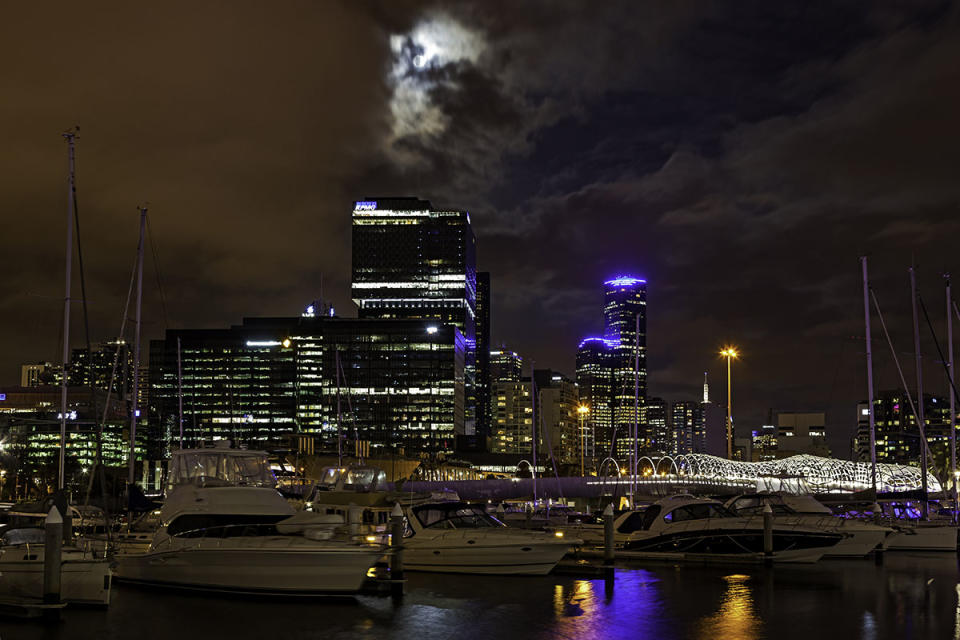When to see the brightest supermoon of the year in Australia tonight
Get your telescopes ready – tonight’s show-stopping supermoon is set to be the brightest lunar event of the year.
At its closest proximity to Earth (known as perigree), the moon will appear 14 per cent larger and 30 per cent brighter than when the moon is on its furthest orbit (known as apogee).
Australian stargazers will be able to view the spectacular sight from Tuesday evening, but there’s one thing to look out for – cloud cover. Read below to find out if your capital city will be affected.
Is it safe to look at?
If you’re using a telescope you might want to use a filter to protect your eyes.
Adam Joyce, senior scientific officer at Macquarie University’s Department of Physics and Astronomy, told Yahoo7 News the moon could be bright enough to cause a strain on the eye.
“It might actually be too bright to look at through a telescope without something there to protect your eyes,” he said.

What is a supermoon?
The moon’s orbit isn’t perfectly circular, so several times a year – mostly at the end or beginning of the year – the moon comes closer to Earth and produces a supermoon, Adam Joyce, senior scientific officer at Macquarie University’s Department of Physics and Astronomy, told Yahoo7 News.
“The moon is going to be in its closest approach to the Earth, that’s why it does look bigger and brighter,” Mr Joyce said.
“It will probably be pretty similar to the 2016 supermoon… It will be pretty spectacular.”
When the moon is at its closest point to our planet, it will be about 356,800 kilometres away from Earth.
Best times to watch in each capital city
The moon is set to reach its fullest phase at 2:53am [AEST] on Wednesday morning, but experts believe the best time to observe the event is at ‘moonrise’ – when the moon is rising up from the horizon.
“The times that you really want to see it is when it’s on the horizon. Otherwise another spectacular time to see it would be when it’s highest in the sky,” My Joyce said.
And while each city will have slightly different moonrise times, one thing that can ruin a viewing is cloud cover.

In Sydney, the moon will rise at 7:39pm (local time). But if you were planning to head outside and have a look, you might be out of luck. Heavy cloud cover is expected to loom over the city throughout the night.
For Melbourne residents, the supermoon will rise at 8:11pm, but cloud cover will again hinder the view.
In Adelaide and Perth, residents can also expect the moon to rise at 8:11pm. Both cities will have magnificent views with barely any cloud cover.
In Brisbane, those wanting to catch a glimpse of the event should head outside at 6:21pm. The city is predicted to have a cloud-free night – perfect for those wanting to get a clear photo of the moon.
For Darwin residents, the moon will show at 7:04pm, but just like Sydney and Melbourne, heavy cloud cover could block the magnificent sight from being seen.
In Hobart, the moon will make an appearance at 8:12, but unfortunately there will be plenty of clouds about at the same time. If you’re prepared for a late night however, the clouds are expected to clear between 10pm and 2am.

Past and future supermoons
The supermoon on November 14, 2016, was the closest to Earth since Australia Day in 1948.
The next time a supermoon will beat that record will be on November 25, 2034.
The longest total lunar eclipse this century passed over Australia in July last year, and brought with it an intense blood moon.
The entire event lasted more than six hours.
NASA explains the supermoon
Tonight’s supermoon will be the last of 2019, but two are expected next year on March 10 and April 8, and two more in 2021 on April 27 and May 26.
According to NASA, the definition of ‘supermoon’ has slightly changed in recent years because of its growing popularity with the public.
“Originally a term from modern astrology for a new or full moon that occurs when the moon is within 90% of its closest approach to Earth in a given orbit, supermoon now refers more broadly to a full moon that is closer to Earth than average,” NASA said.
Do you have a story tip? Email: y7newsroom@yahoo7.com.au.
You can also follow us on Facebook and Twitter and stay up to date with the latest news with Yahoo7’s daily newsletter. Sign up here.



